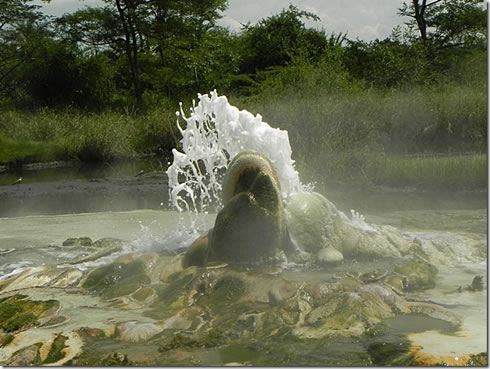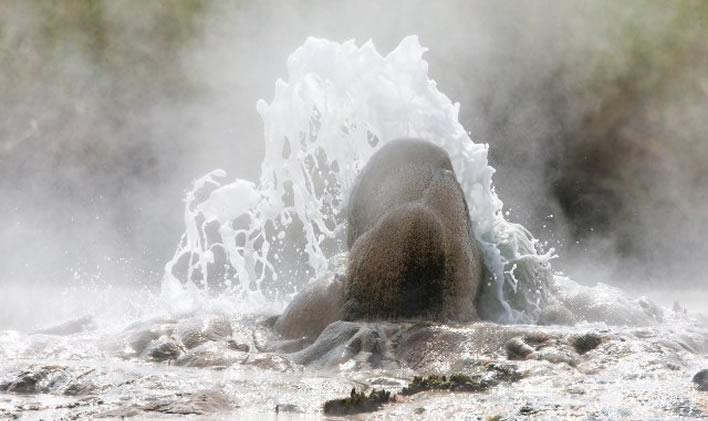Western Uganda is gifted with a variety of physical features which attract tourists. These include but not limited to: Lake Mburo National park, Queen Elizabeth national park, Rwenzori mountains national park, Bwindi impenetrable national park, Mgahinga gorilla national park and Semuliki National Park.
Among the most attractive features are the hot springs in Semuliki national park. Scientists describe a hot spring as a spring produced by the emergence of geothermal-heated groundwater from the earth’s crust. Hot springs are formed when water come into contact with the heated rock. If water percolates deeply enough into the crust, it will be heated as it comes into contact with hot rocks.
Hot springs are formed by cracks extending down towards the exceedingly hot temperatures of the mantle, and water seeping downwards is heated and forced back up under pressure to bubble. Uganda’s hot springs are found in four main locations; Around Murchison falls national park area, Fort Portal area, Queen Elizabeth national park area and Bwindi impenetrable forest national park area.
1. Fort Portal Area
Semiliki National Park which is situated in south western Uganda making a possible enroute Bwindi impenetrable forest national park for gorilla trekking. In this park, hot springs are the major tourist attraction. The hot springs here include;
 Sempaya hot springs are Semiliki’s most famous attraction. They are set in a lush swampy clearing close to the south eastern corner of the forest of Semiliki. These two hot springs are in two sites and are each distinct from each other. There is the Female Spring and the Male Spring.
Sempaya hot springs are Semiliki’s most famous attraction. They are set in a lush swampy clearing close to the south eastern corner of the forest of Semiliki. These two hot springs are in two sites and are each distinct from each other. There is the Female Spring and the Male Spring.
The female spring has water boiling at 103 degrees, and it spurts hot water up to 2m above the ground while the male spring is more distant from the female spring and is reached by following a trail.
Water from hot springs is believed to cure certain diseases for example ringworm. There are also legends and customs related to the hot springs that you will get in detail by the help of a professional tour guide.
The female spring is visited by women who hope for cure for infertility and other problems. Communities living near hot springs in Uganda usually have both spiritual and superstitious attachments to them. Uganda’s hot springs are often popular tourist destinations and locations for rehabilitation clinics for those with disabilities. The trail to the springs leads you through a patch of rain forest where red-tailed monkey, grey-cheeked mangabey and black and white colobus are common. Bird watching safaris are also stunning; you will see different bird species like forest horn.Tourists have been seen boiling eggs, cassava and green bananas in the two geothermal heated springs.
Buranga Hot springs
Fort portal is one of the nearest towns to Rwenzori mountains making it the best stop over town before proceeding to Buranga hot springs. On your way to the hot springs, you are welcomed through the lowland tropical rain forest.
The only edge that Buranga hot springs have over Sempaya hot springs is the number of hot springs. Buranga hot springs are formed by three hot springs dispersed in a walk-able distance from each other. These are Mumbuga springs, Nyansimbe springs and Kagoro springs. These are all recommended en-routes activities for Kibale forest national park and Rwenzori mountains.
Rwagimba Hot springs
When you think of hot springs in Uganda, you need to identify the most unique of all hot springs and this is Rwagimba hot springs found in river Rwimi in Bunyangabu district. Besides the common stories of this river flooding in the rainy seasons; Rwagimba hot springs offer steam baths that draw multitudes to this place.
It is also a recommend en-route destination for Kibale forest national park, Rwenzori mountains, and Bwindi impenetrable forest national park
2. Queen Elizabeth National Park Area
There is one hot spring closest to the Queen Elizabeth area; Kitagata hot springs.
Kitagata Hot Springs
The hot spring is located one kilometer from the Kitagata trading center and has water temperatures as hot as 80 degrees centigrade. The springs also have historical importance as one was used by the King of Ankole and hence referred to locally as ‘Ekyomugabe’, the King’s Spring while the other adjacent one is more known for its medicinal value and referred to as Mulago in reference to Uganda’s national referral hospital which is Mulago. Kitagata hot springs are a must visit to anyone visiting Bushenyi district and are on the route that easily connects to Queen Elizabeth, Bwindi and Lake Mburo National Parks.
Many visitors travel to Kitagata to treat themselves to the hot baths or just to catch a glimpse of people bathing in these natural hot Spas. Kitagata hot springs are also well known for their curative waters. Patients from as far as 100 kms flock the springs to soak themselves in the spring waters to heal them, some other patients drink the sulphur rich waters of the hot springs for cure from rheumatism and arthritis.
A medical research is yet to be conducted to prove the claims of the above cures. Among all the hot springs in Uganda, Kitagata hot springs might be the busiest attracting over 20 people on a good day trying to take a bath in this natural warm water as well as boiling some eggs, cassava, bananas and sweet potatoes in springs hot water.The hot springs have several pools just around the hot springs from which people collect some warm water for drinking while at the springs.
3. Murchison Falls National Park Area
Amoropii hot springs
Uganda also has the Amoropii hot springs in northern Uganda which is believed to do miracles for its visitors. These hot springs are rooted in the worship traditions of the Alur people because it’s believed to have divine powers. Amoropii hot springs got its name from Alur words meaning hot water. “Amoro” means hot and “pii” stands for water.
It is believed that barren women bathe in the hot spring as well as those in need of a fairer and tender skin. However, one must first get permission to visit these springs and illegal visiting of these hot springs may cause you problems such as snake bits.
 It is also believed that hot springs are related to traditional briefs for example every six months; they slaughter a big sheep as a sacrifice to the gods of Amoropii. The meat is left in the open and the following day, it’s gone. It is believed that the gods of Amoropii take it.
It is also believed that hot springs are related to traditional briefs for example every six months; they slaughter a big sheep as a sacrifice to the gods of Amoropii. The meat is left in the open and the following day, it’s gone. It is believed that the gods of Amoropii take it.
Kibiro Hot Springs
Kibiro Hot springs are some of the least known and the least visited hot springs in Uganda. This is partly because of it remote location compared to all the other hot springs. However with a well planned itinerary and good safari cars, the place easily be accessed on a non rainy day. It is also a recommended enroute destination in case you are coming from Murchison falls national park heading to Kibale forest national park or accessing Murchison falls national park via Hoima town.
4. Bwindi Impenetrable Forest National Park Area
There is one Hot spring that is highly recommended for anyone doing gorilla trekking in Bwindi impenetrable forest national park and visiting lake Bunyonyi; Ihimba Hot springs
Ihimba Hot springs
These hot springs are located in Kabale western Uganda. They have a long history of the bahima people which make them a special destination for anyone who loves culture. You can also visit the local bahima people in this area garnishing your western Uganda trip with a feel of culture and hot spring scenery.
Like all the other hot springs in Uganda, Ihimba hot springs has a long trail of notable healing among the local people though not yet scientifically proven.

